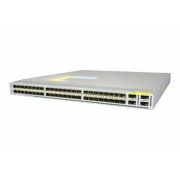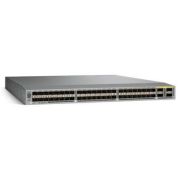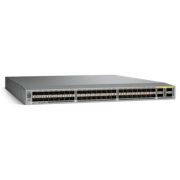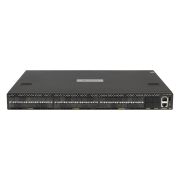В комплект входит:
- Содержит функционал Layer 3 Enterprise Services Package (лицензия N3K-LAN1K9), в том числе Layer 3 Base Services Package (N3K-BAS1K9) Описание функционала
- Блок питания AC N2200-PAC-400W (Port Side Exhaust) или N2200-PAC-400W-B (Port Side Intake) - 2 шт.
- Блок вентиляторов N3K-C3064-FAN (Port Side Exhaust) или N3K-C3064-FAN-B (Port Side Intake) - 1 шт.
Модель блоков питания и вентиляторов уточняйте у менеджера.
Крепления и дополнительные лицензии в комплект не входят
Обзор продукта
Коммутатор Cisco Nexus® 3064-X - это высокопроизводительные коммутатор Ethernet, который входит в семейство коммутаторов Cisco Nexus серии 3000.
Этот компактный 10-гигабитный Ethernet-коммутатор с форм-фактором 1RU обеспечивающий коммутацию на уровне 2 и 3 на линейной скорости. Работая под управлением ведущей в отрасли операционной системы Cisco® NX ‑ OS Software, коммутатор предоставляет заказчикам комплексные решения, которые широко распространены по всему миру.
Коммутаторы Cisco Nexus 3064-X хорошо подходят для центров обработки данных, которым требуются эффективные по стоимости затрат и энергосберегающие коммутаторы верхнего (ToR) уровня 2 и 3 с линейной скоростью.
Основное отличие от коммутаторов Cisco Nexus 3064PQ - это более высокая энергоэффективность и более низкая скорость задержки коммутации.
Основные особенности:
- 48 портов 10 Гбит/с SFP+ (могут работать на скоростях 100 Мбит/с, 1 Гбит/с и 10 Гбит/с)
- 4 порта аплинка 40 Гбит/с QSFP+ (каждый из портов аплинка можно настроить как 4 x 10 Гбит/с)
- Пропускная способность 1.28 Тбит/с
- Передача до 950 миллионов пакетов в секунду (Mpps)
- Таблица MAC 128000
- Буфер 9 MB
- Память DRAM 4 GB
- Boot flash память 2 GB
- MTU до 9216 байт (jumbo frames)
- 2 блока питания (AC или DC)
- Прямое (Port-side exhaust) и обратное (Port-side intake) охлаждение
- Низкое энергопотребление
- Неблокируемая L2/L3 коммутация
- Низкая задержка коммутации

| Функционал | Спецификация |
| Layer 2 | ● Layer 2 switch ports and VLAN trunks
● IEEE 802.1Q VLAN encapsulation
● Support for up to 4096 VLANs
● Rapid Per-VLAN Spanning Tree Plus (PVRST+) (IEEE 802.1w compatible)
● Multiple Spanning Tree Protocol (MSTP) (IEEE 802.1s): 64 instances
● Spanning Tree PortFast
● Spanning Tree Root Guard
● Spanning Tree Bridge Assurance
● Cisco EtherChannel technology (up to 32 ports per EtherChannel)
● Link Aggregation Control Protocol (LACP): IEEE 802.3ad
● vPC
● Jumbo frames on all ports (up to 9216 bytes)
● Storm control (unicast, multicast, and broadcast)
● Private VLANs |
| Layer 3 | ● Layer 3 interfaces: Routed ports on interfaces, switch virtual interfaces (SVIs), PortChannels, and subinterfaces (total: 1024)
● 64-way ECMP
● 2000 ingress and 1000 egress ACL entries
● IPv6 routing: Static, OSPFv3, and BGPv6
● Routing protocols: Static, RIPv2, EIGRP, OSPF, and BGP
● Bidirectional Flow Detection (BFD) for BGP, OSPF and ipv4 Static routes
● HSRP and VRRP
● ACL: Routed ACL with Layer 3 and 4 options to match ingress and egress ACLs
● VRF: VRF-lite (IP VPN), VRF-aware unicast (BGP, OSPF, and RIP), and VRF-aware multicast
● Unicast Reverse-Path Forwarding (uRPF) with ACL; strict and loose modes
● Jumbo frame support (up to 9216 bytes)
● Generic Routing Encapsulation (GRE) tunneling |
| Multicast | ● Multicast: PIMv2, PIM-SM, and SSM
● Bootstrap router (BSR), Auto-RP, and Static RP
● Multicast Source Discovery Protocol (MSDP) and Anycast RP
● Internet Group Management Protocol (IGMP) Versions 2 and 3 |
| QoS | ● Layer 2 IEEE 802.1p (class of service [CoS])
● 8 hardware queues per port
● Per-port QoS configuration
● CoS trust
● Port-based CoS assignment
● Modular QoS CLI (MQC) compliance
● ACL-based QoS classification (Layers 2, 3, and 4)
● MQC CoS marking
● Differentiated services code point (DSCP) marking
● Weighted Random Early Detection (WRED)
● CoS-based egress queuing
● Egress strict-priority queuing
● Egress port-based scheduling: Weighted Round-Robin (WRR)
● Explicit Congestion Notification (ECN)
● Configurable ECN (Marking) per port |
| Security | ● Ingress ACLs (standard and extended) on Ethernet
● Standard and extended Layer 3 to 4 ACLs include IPv4, Internet Control Message Protocol (ICMP), TCP, and User Datagram Protocol (UDP)
● VLAN-based ACLs (VACLs)
● Port-based ACLs (PACLs)
● Named ACLs
● ACLs on virtual terminals (vtys)
● DHCP snooping with Option 82
● Port number in DHCP Option 82
● DHCP relay
● Dynamic Address Resolution Protocol (ARP) inspection
● Configurable CoPP |
| Management | ● POAP
● Python scripting
● Cisco EEM
● Switch management using 10/100/1000-Mbps management or console ports
● CLI-based console to provide detailed out-of-band management
● In-band switch management
● Locator and beacon LEDs
● Configuration rollback
● SSHv2
● Secure Copy (SCP) server
● Telnet
● AAA
● AAA with RBAC
● RADIUS
● TACACS+
● Syslog
● Syslog generation on system resources (for example, FIB tables)
● Embedded packet analyzer
● SNMP v1, v2, and v3
● Enhanced SNMP MIB support
● XML (NETCONF) support
● Remote monitoring (RMON)
● Advanced Encryption Standard (AES) for management traffic
● Unified username and passwords across CLI and SNMP
● Digital certificates for management between switch and RADIUS server
● Cisco Discovery Protocol Versions 1 and 2
● RBAC
● Switched Port Analyzer (SPAN) on physical layer, PortChannel, and VLAN
● Tunable Buffer Allocation for SPAN
● Encapsulated Remote SPAN (ERSPAN)
● Ingress and egress packet counters per interface
● PTP (IEEE 1588) boundary clock
● Network Time Protocol (NTP)
● Cisco OHMS
● Comprehensive bootup diagnostic tests
● Cisco Call Home
● Cisco DCNM
● Advanced buffer utilization monitoring
● sFlow |






















